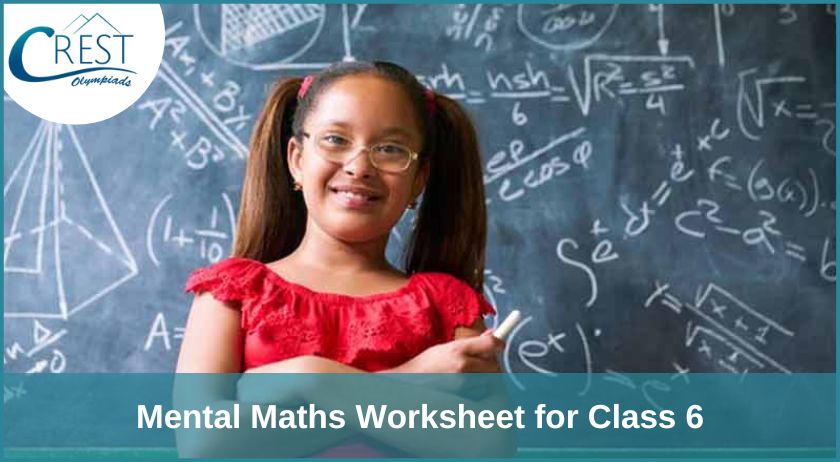Mental Maths worksheet for class 6 designed for students helps to develop and improve the child's mental arithmetic skills, which will enable them to solve problems faster and with greater accuracy. This can also increase their confidence in their abilities and help to reduce stress and anxiety when it comes to mathematics.
Additionally, Mental Maths worksheet for class 6 help to strengthen the child's memory, as they must recall and use mathematical concepts, formulas and rules that they have learned in previous lessons. This repetition helps to cement the information in their memory and makes it easier for them to recall it in future lessons.
Overall, Mental Maths worksheet for class 6 provide a fun, interactive and effective way for children to practice and improve their mathematical skills. They can be used as a supplement to the regular Math curriculum or as a standalone activity to help children further develop their understanding of Mathematics. Students are recommended to practice following Mental Maths questions for class 6.

Mental Maths Worksheet for Class 6
1. What is the sum of 25 + 50?
a) 75
b) 100
c) 50
d) 125
Answer: a) 75
Explanation: Adding 25 and 50 gives us 75.
2. What is the difference between 100 and 50?
a) 150
b) 50
c) 150
d) 50
Answer: b) 50
Explanation: Subtracting 50 from 100 gives us 50.
3. What is the product of 5 x 10?
a) 50
b) 5
c) 10
d) 100
Answer: a) 50
Explanation: Multiplying 5 and 10 gives us 50.
4. What is the result of 50 divided by 10?
a) 5
b) 50
c) 10
d) 500
Answer: a) 5
Explanation: Dividing 50 by 10 gives us 5.
5. What is the result of 2 raised to the power of 3?
a) 6
b) 8
c) 2
d) 9
Answer: b) 8
Explanation: 2 raised to the power of 3 gives us 8 (2 x 2 x 2 = 8).
6. What is the correct order of operations according to PEMDAS?
a) Parentheses, Exponents, Multiplication, Division, Addition, Subtraction
b) Parentheses, Exponents, Addition, Multiplication, Subtraction, Division
c) Parentheses, Addition, Exponents, Multiplication, Division, Subtraction
d) Parentheses, Multiplication, Exponents, Addition, Subtraction, Division
Answer: a) Parentheses, Exponents, Multiplication, Division, Addition, Subtraction
Explanation: PEMDAS stands for Parentheses, Exponents, Multiplication, Division, Addition, Subtraction, and is the order in which arithmetic operations should be performed in a mathematical expression.
7. What is the solution to the equation x + 2 = 5?
a) 3
b) -3
c) 7
d) -7
Answer: a) 3
Explanation: To find the solution to the equation x + 2 = 5, we need to isolate x by subtracting 2 from both sides. So, x + 2 - 2 = 5 - 2. This gives us x = 3, which is our answer.
8. Which of the following is an example of a two-step equation?
a) y = 2x + 1
b) 2x + 1 = 7
c) x + 3 = 9
d) x - 4 = 10
Answer: b) 2x + 1 = 7
Explanation: A two-step equation involves solving for x by first isolating it on one side of the equation, and then finding its value. In this case, we can isolate x by subtracting 1 from both sides, giving us 2x = 6. Then, we can divide both sides by 2 to find x = 3.
9. What is the solution to the inequality 3x - 5 > 10?
a) x < 3
b) x > 3
c) x < 5
d) x > 5
Answer: d) x > 5
Explanation: To find the solution to the inequality, we need to isolate x on one side. Adding 5 to both sides gives us 3x > 15. Then, we can divide both sides by 3 to get x > 5. Since the inequality symbol is >, we know that the solution is all values greater than 5, or x > 5.
10. What is the simplified form of the expression 3x + 4y - 2x + 6?
a) x + 10y + 4
b) x + 10y
c) 2x + 4y + 6
d) x + 4y + 6
Answer: d) x + 4y + 6
Explanation: The simplified form of an expression is achieved by combining like terms and eliminating any unnecessary terms. In this expression, we can simplify 3x + -2x to give us x. We can also add 4y + 6 to give us 4y + 6. Thus, the simplified form is x + 4y + 6.

11. Which of the following is not an algebraic expression?
a) 2x + 3
b) x2 + 1
c) 3y - 5
d) 9 + 7
Answer: d) 9 + 7
Explanation: An algebraic expression is a mathematical phrase that can contain numbers, variables, and operators such as addition, subtraction, multiplication, and division. 9 + 7 is a mathematical expression but not an algebraic expression as it does not contain any variables.
12. What is the solution to the equation 2x - 4 = 10?
a) 7
b) 8
c) 9
d) 6
Answer: a) 7
Explanation: To find the solution to the equation, we need to isolate x. Adding 4 to both sides gives us 2x = 14. Then, we can divide both sides by 2 to get x = 7.
13. What is the perimeter of a square with side length 4 cm?
a) 12 cm
b) 16 cm
c) 18 cm
d) 20 cm
Answer: b) 16 cm
Explanation: The perimeter of a square is calculated by adding up all four sides. In this case, each side measures 4 cm, so the total perimeter is 4 cm x 4 sides = 16 cm.
14. What is the volume of a cube with side length 3 cm?
a) 9 cm3
b) 27 cm3
c) 81 cm3
d) 243 cm3
Answer: b) 27 cm3
Explanation: The volume of a cube is calculated by finding the cube of the side length. In this case, the side length is 3 cm, so the volume is 3 cm x 3 cm x 3 cm = 27 cm3.
15. What is the area of a rectangle with length 6 cm and width 4 cm?
a) 14 cm
b) 24 cm
c) 36 cm
d) 48 cm
Answer: b) 24 cm
Explanation: The area of a rectangle is calculated by multiplying the length by the width. In this case, the area is 6 cm x 4 cm = 24 cm2.
16. A container holds 1 liter of liquid. What is its volume in milliliters?
a) 1000 ml
b) 100 ml
c) 10 ml
d) 1 ml
Answer: a) 1000 ml
Explanation: 1 liter is equal to 1000 milliliters. So the volume of the container in milliliters is 1 liter x 1000 ml/liter = 1000 ml.
17. Justin weighs 80 kilograms, Benjamin weighs 40 kilograms and Jack weighs 60 kilograms. How much do the 3 people weigh altogether in grams?
a) 100000 g
b) 120000 g
c) 180000 g
d) 140000 g
Answer: c) 180000 g
Explanation: Justin weighs 80 kilograms= 80 x 1000 = 80000 g. Benjamin weighs 40 kilograms = 40 x 1000 = 40000 g. Jack weighs 60 kilograms = 60 x 1000 = 60000 g. Therefore, 3 people weight = 80000 + 40000 + 60000 = 180000 g.
18. What is the length of a rod with a mass of 2 kg and a density of 1000 kg/m3?
a) 0.002 m
b) 0.02 m
c) 0.2 m
d) 2 m
Answer: c) 0.2 m
Explanation: The volume of a rod can be calculated using the equation volume = mass/density. In this case, the volume of the rod is 2 kg / 1000 kg/m3 = 0.002 m3. The length of the rod can be found by dividing the volume by its cross-sectional area, which is assumed to be a constant. Thus, the length of the rod is 0.002 m3 / area = 0.2 m.
19. What is the equivalent fraction of 3/4?
a) 4/3
b) 4/7
c) 6/9
d) 9/12
Answer: d) 9/12
Explanation: To convert a fraction to an equivalent fraction, you can multiply the numerator and denominator by the same number. For example, 3/4 can be converted to 9/12 by multiplying both the numerator and denominator by 3.
20. What is the fraction which is equal to 1/5?
a) 2/10
b) 1/14
c) 3/18
d) 7/21
Answer: a) 2/10
Explanation: To find the equivalent fractions, we multiply the numerator and the denominator by the same number. In this case, we multiply both the numerator and denominator of the given fraction by 2 which gives 2/10.
21. What is 50% of 200?
a) 100
b) 150
c) 175
d) 200
Answer: a) 100
Explanation: To find 50% of a number, divide the number by 2. In this case, 200 ÷ 2 = 100, which is 50% of 200.
22. If a = b, what is the ratio of a to b?
a) 1
b) 2
c) 4
d) 8
Answer: a) 1
Explanation: If a and b are equal, the ratio of a to b is 1.
23. What is the mean of the numbers 8, 9, 10, 11, and 12?
a) 9
b) 10
c) 11
d) 12
Answer: b) 10
Explanation: The mean of a set of numbers is the sum of the numbers divided by the number of numbers. In this case, the sum of the numbers is 8 + 9 + 10 + 11 + 12 = 50, and the number of numbers is 5. So, the mean is 50 ÷ 5 = 10.
24. If it is currently 8:00 PM, what time will it be in 4 hours?
a) 12:00 AM
b) 12:00 PM
c) 11:00 PM
d) 11:00 AM
Answer: a) 12:00 AM
Explanation: 4 hours after 8:00 PM is 12:00 AM.

Solve!!!
1. What is the equivalent fraction of 3/4?
a) 4/3
b) 6/8
c) 9/12
d) 12/16
2. What is the fraction equivalent to 50%?
a) 1/2
b) 5/11
c) 2/5
d) 3/5
3. What is the ratio of boys to girls in a class with 30 students and 20 boys?
a) 2:3
b) 2:5
c) 3:5
d) 3:2
4. What is the mean of the numbers 1, 2, 3, 4 and 5?
a) 2.5
b) 3
c) 3.5
d) 4
5. What is the median of the numbers 5, 2, 8, 1 and 6?
a) 5
b) 3.5
c) 4
d) 6
6. The range of the numbers 3, 4, 5, 6 and 7 is:
a) 1
b) 2
c) 3
d) 4
7. What is the time when the clock shows 3:45 PM?
a) 15:45
b) 15:15
c) 45:15
d) 45:03
8. Simplify the expression 2x + 3y
a) 2xy + 3
b) 5xy + 3
c) 2x + 3y
d) 5x + 3y
9. What is the perimeter of a square with side length 5 cm?
a) 10 cm
b) 15 cm
c) 20 cm
d) 25 cm
10. What is the volume of a cube with side length 7 cm?
a) 21 cm
b) 49 cm
c) 343 cm
d) 245 cm
Answers
1. b) 6/8
2. a) 1/2
3. d) 3:2
4. a) 2.5
5. c) 4
6. b) 2
7. a) 15:45
8. c) 2x + 3y
9. c) 20 cm
10. c) 343 cm

Mental Maths Worksheet PDF for Class 6
Mental Maths worksheet PDF for class 6 is easily accessible here and offers various different levels of questions with solutions to make learning more effective for students.
This worksheet helps students to practice and improve their Mental Maths skills on a daily basis. Mental Maths worksheet for class 6 comes with an answer key, making it easy for students to check their work and evaluate their progress. It also helps students to identify areas where they need to improve and work on them.
Students can practice and sharpen their skills by downloading class 6 Mental Maths worksheet for free. The following is the link to the download pdf for class 6 Mental Maths Worksheet.
Download PDF for Mental Maths Worksheet for Class 6









